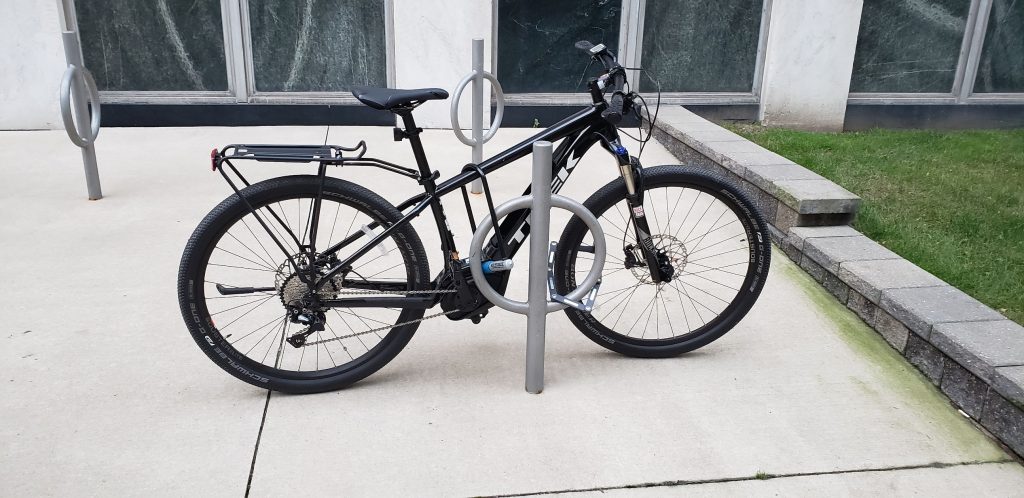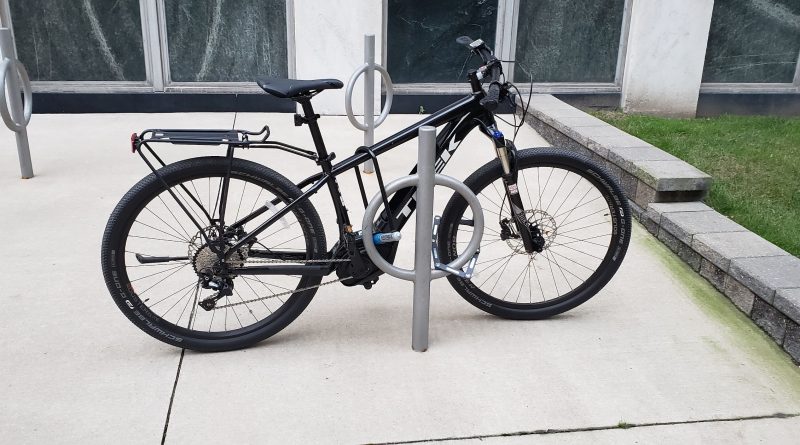Libert-e-bikes: Marketing Mobility As Freedom
As I’m dealing with the aftermath of a car totaled from contaminated gasoline– long story, don’t worry, we’ll get into it eventually- I put on my accounting hat and took a look at how much money I have spent on my car since I bought it. I especially wanted to compare this to how much I’ve spent on my eBike, which cost a pretty penny. For the car, it’s kind of a disappointing number, although it gets a little bit rosier when I consider that the projected residual value was actually way lower than the payout I ended up getting. The adjuster and I both figured that this was probably a product of the messed up used car market right now. Chip shortages, COVID, whatever. But this made me think a bit more about ebike marketing, as I’ve been thinking about replacing the car with an ebike that is suited to do things like carry a week’s worth of groceries. Or, you know, dogs, as I have a couple of those. In particular, I looked at Urban Arrow, which makes $6000-8000 cargo ebikes billed as mobility solutions for the whole family. Their marketing material makes an impressive pitch. It also appeals to my perception that these issues are not just infrastructural or technological– they’re as much cultural.

The Bucks: eBike vs. Car
eBike marketing has often disproportionately focused on the “fun” aspect of cycling. Bike go vroom! It’s especially apparent when companies are advertising with pictures of people, well, off-roading, since their bikes aren’t generally street legal at speeds that sometimes exceed the Level 3 eBike category by a factor of 2 or 3. We see this phenomenon in higher-end bikes like the Delfast, the Sondors Metacycle, the Optibike, or, well, anything from those clever but utterly cantankerous purveyors of house-built eBikes, Luna Cycle. (Side note: I’ve been thinking about writing a whole piece about how not to do customer service based on reading about some of their customer interactions. This makes transforming an entire market rather challenging, too!). When I say “higher-end” here I mean. “comparably priced to a car.” The Optibike can run you a princely sum of $12-15k, while the Delfast could be found for as little as a third of that.
Cars, on the other hand, are really, really expensive, however you slice it. What does a new car cost these days? Turns out the average for light vehicles, a.k.a. not-trucks– based on individual sales (as opposed to binning each sale into a specific model type, which would likely skew the distribution toward more expensive cars), is around $40,000. Yes, you read that correctly. Pickup trucks average around $48,000, so, a full 20% premium. (But tell me more about how bicycles are the elitist mode of transportation?). There are some complicating factors here. Cars are lasting far longer today than they did a generation ago. They are, however, more expensive to maintain, with far more specialized parts including all the compyutas. Used cars are around half the price of new ones, and this is more like 60% of the price of a new car. Pricing new vs. used is challenging when you’re not able to easily segment a consideration of lightly-used (say, 2018-2022 model years) versus bargain range (2004-2015).
Estimated Cost Figures: Car Vs. Bike
So, AAA figures the average American pays $10,000 a year for a car. That tracks with the $40,000 price range, especially considering the high cost of insurance and maintenance (more so as a car ages). But check out the comparison here:
| Vehicle | Purchase Price | Residual | Insurance | Reg & Taxes | Maintenance | Fuel | 3-yr. ownership | residual % of total |
| Trek – Police Model Electric Bike | $ 4,000.00 | $ 2,000.00 | $ 252.00 | $ 240.00 | $ 250.00 | $ 50.00 | $ 4,792.00 | 42% |
| 2009 Honda Fit | $ 3,600.00 | $ 250.00 | $ 5,616.00 | $ 900.00 | $ 1,500.00 | $ 1,500.00 | $ 13,116.00 | 2% |
| 2006 Honda Civic | $ 6,000.00 | $ 5,000.00 | $ 5,616.00 | $ 900.00 | $ 2,500.00 | $ 1,500.00 | $ 16,516.00 | 30% |
The above table is hardly scientific. My partner bought her car many years ago, so I’m thinking about what it would have cost had she bought it at roughly the same time that I bought my eBike and, later, my since-dearly-departed car (RIP). There are some other issues with the above data. I got a payout of nearly $5,000, not a payout of the estimated $250. This $5000 is more than I paid for the car, and it’s more than I was looking to get. However, the used car market is very hot right now, and I had *just* spent a bunch of money on new wheels and new tires, which collectively drive up the value by a bunch. There were also a bunch of new parts installed in the engine before it was totaled.
But the fact is, most cars will eventually depreciate to 2% of their purchase price– scrap metal, essentially, once key parts start rusting through. This can happen even with basic, preventive maintenance. The same is much harder to have happen on a bike. I mention this as a lengthy digression because the table shows the staggering cost of owning an inevitably depreciating asset over time. In 2020 and 2021, for example, my partner and I will have paid nearly $8000 for insurance on a pair of cars that moved surprisingly little and end up being worth surprisingly little money. But back to the bike vs. car thing.
Mismatching Dollar Pricing and Perceived Value
One of the problems in eBikes conquering the automotive paradigm involves a misalignment in what people think a car is worth versus what it actually costs. There are arguments to be made on either side, variously by what I might call New Capitalists like myself, who believe in things like externalities and worker rights, or, on the other side, by the likes of neoliberal apologists who say, well, we did a study showing that people Make Rational Decisions Always, and yes, cars are great! An interesting podcast from an Ivory Tower MIT Sloan professor and a researcher at the MITEI Mobility Systems Center tried to quantify this value. It’s worth a listen if you’ve got the time. But they basically argue that people value their cars at more than what they would save by giving them up.
In terms of their comparative fuel efficiency, eBikes are something like 10-20 times more efficient than even an electric car. This means you’re not only saving money on the maintenance and insurance and purchase side of things, you’re also paying, quite literally, just pennies to charge the thing.
It’s specious. People don’t understand how value works. And this doesn’t mean people are dumb. It means that there are so many levels of abstraction between dollars in the bank account versus the myriad of externalities and contributing factors to cost. In Marxist terms, a similar concept is referred to as “alienation” (or “estrangement,” in German, Entfremdung, “Ent-” for an action, initiating, or emphasizing thing, “fremd” for “foreign,” “-ung” for “-ing,” blah blah blah, there’s your language lesson for the day). For example: It’s valuable for me to have clean air. That, to me, is worth paying an extra 5 or 10 or 25 cents in gas tax. Hell, I’d pay an extra $5 in gas taxes if it meant having clean air and public transit. Many bike advocates are with me on this. Car aficionados are not. It’s an extreme example, and clearly $5 would be utterly regressive in the short run. But a gas tax or a carbon tax can illustrate how we can resolve some of these layers of abstraction.

$200 Too Pricey For A Bike; Lemme Just … Buy A $30,000 Car?
I recall a conversation with a friend here in Michigan who asked me about buying her first bike. I told her about some styles and configurations that might be worth checking out, and I said they could usually be found for a few hundred bucks, used. She balked at that price. “Oh, that’s way too expensive!” I was pretty floored. This was a white collar professional making more than enough money to afford this small cost for a vehicle. A couple hundred bucks is too expensive? Oddly, this same friend ended up buying a $30,000 compact SUV. The payments alone for this would have to be more than $300 per month. Plus insurance. (And, according to the consumer research data I mentioned earlier, this is “cheap” compared to other “light” vehicles).
This misalignment of values is also apparent when conservatives rail against liberal elitists and their spandex and high-end road bikes (that might cost, you know, a grand or less), while driving that pinnacle of working-class virtue, a $48,000 Dodge Ram truck.
Can eBikes actually conquer this paradigm and make freedom and liberty their own thing? In terms of their comparative fuel efficiency, eBikes are something like 10-20 times more efficient than even an electric car. This means you’re not only saving money on the maintenance and insurance and purchase side of things, you’re also paying, quite literally, just pennies to charge the thing. That’s money you can use on, well, anything else. It seems, if nothing else, like the vast dollar savings associated with eBikes should make enough of a case on its own. Don’t worry– local delivery of gigantic things like couches or construction materials will still be done in larger vehicles. This is unavoidable. But for the vast majority of trips, there’s no reason why the average consumer can’t free themselves from that $10,000-per-year effective tax on their life and enjoy the open road on two wheels.






